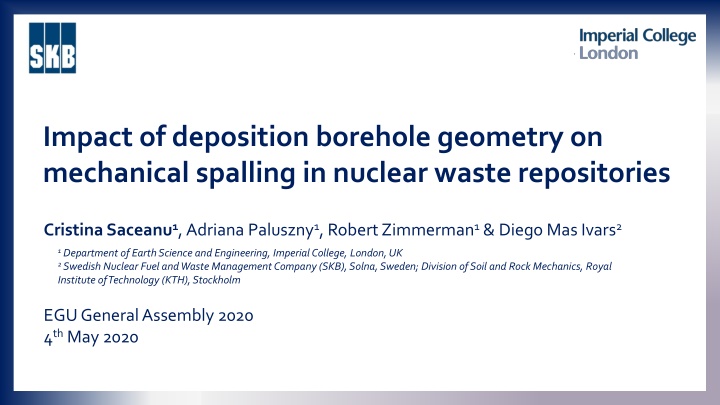
Impact of Borehole Geometry on Mechanical Spalling in Nuclear Waste Repositories
Explore the impact of borehole geometry on mechanical spalling in nuclear waste repositories through simulations and experimental setups. Learn about spalling as a type of rock failure, modeling approaches, and key results affecting deep excavations.
Uploaded on | 0 Views
Download Presentation

Please find below an Image/Link to download the presentation.
The content on the website is provided AS IS for your information and personal use only. It may not be sold, licensed, or shared on other websites without obtaining consent from the author. If you encounter any issues during the download, it is possible that the publisher has removed the file from their server.
You are allowed to download the files provided on this website for personal or commercial use, subject to the condition that they are used lawfully. All files are the property of their respective owners.
The content on the website is provided AS IS for your information and personal use only. It may not be sold, licensed, or shared on other websites without obtaining consent from the author.
E N D
Presentation Transcript
Impact of deposition borehole geometry on mechanical spalling in nuclear waste repositories Cristina Saceanu1, Adriana Paluszny1, Robert Zimmerman1 & Diego Mas Ivars2 1 Department of Earth Science and Engineering, Imperial College, London, UK 2 Swedish Nuclear Fuel and Waste Management Company (SKB), Solna, Sweden; Division of Soil and Rock Mechanics, Royal Institute of Technology (KTH), Stockholm EGU General Assembly 2020 4th May 2020
Spalling & Nuclear Waste Disposal 1 Spalling is a common type of rock failure that occurs at the boundaries of deep excavations, and it is usually defined as tensile failure that occurs when the tangential stress at the borehole boundary exceeds the tensile strength of the rock (Martin, 2005). Spalling is expected to occur around the deposition boreholes in deep mined nuclear waste repositories (Martin, 2005). Modified from Read (2004) Schematic representation of a deep nuclear waste repository (SKB-TR-10-12 (2010))
Modelling Approach 2 The simulations are conducted using a finite element-based fracture growth simulator that computes deformation in the system based on the mechanical properties of the rock (Paluszny and Matth i, 2009). A damage mechanics approach is used to describe the fracture initiation process (Mazars et al., 2015). Fracture growth is determined by stress intensity factors (SIFs), that are calculated at the fracture tips. These control the stress magnitude at the tips and determine whether or not the crack will extend at the specified tip (Thomas et al., 2020). Failure, length, and angle criteria are evaluated to determine which fracture tips will extend, by how much, and in what direction (Thomas et al., 2020). Initial fracture surface Propagation vectors at different growth steps
Experimental Setup 3 Model Properties (SKB TR-08-05 (2007)) Borehole configurations Rock properties Density Young s Modulus Poisson s Ratio Uniaxial Compressive Strength Tensile Strength KIC Borehole properties Young s Modulus Poisson s Ratio KIC Value used 2.73 g/cm3 76 GPa 0.23 Wedge shaped borehole Circular borehole Cone shaped borehole 226 MPa 13 MPa 3.8 MPa/m1/2 10 Pa 0 1010 MPa/m1/2 Boundary Conditions
Results 4 Cone-shaped borehole Wedge-shaped borehole Circular borehole Maximum Spalling Depth (m) Spalling Width ( ) Total Fracture Surface Area (m2) Borehole configuration Perspective view circular 0.44 63 / 52 2.0 cone 0.47 60 / 62 2.23 wedge 0.49 90 / 47 2.46 Top view
References 1. Martin, D. (2005). Preliminary assessment of potential underground stability (wedge and spalling) at Forsmark, Simpevarp and Laxemar sites. Technical report R-05-71, Svensk Karnbranslehantering AB. 2. SKB TR-10-12 (2010). Design and production of the KBS-3 repository. Technical report TR-10-12, Svensk Karnbranslehantering AB. 3. Read, R. (2004). Twenty years of excavation response studies at AECL s Underground Research Laboratory. International Journal of Rock Mechanics and Mining Sciences, 41(8), 1251-1275. 4. Paluszny, A. and Matth i, S. (2009). Numerical modeling of discrete multi-crack growth applied to pattern formation in geological brittle media. International Journal of Solids and Structures, 46(18-19), 3383-3397. 5. Mazars, J., Hamon, F. and Grange, S. (2015). A new 3D damage model for concrete under monotonic, cyclic and dynamic loadings. Materials and Structures, 48(11), 3779-3793. 6. Thomas, R.N., Paluszny, A., and Zimmerman, R.W. (2020). Growth of three-dimensional fractures, arrays, and networks in brittle rocks under tension and compression. Computers and Geotechnics, 121, 103447. 7. SKB TR-08-05 (2007). Site description of Forsmark at completion of the site investigation phase. SDM-Site Forsmark. Technical report TR-08-05, Svensk Karnbranslehantering AB.






















